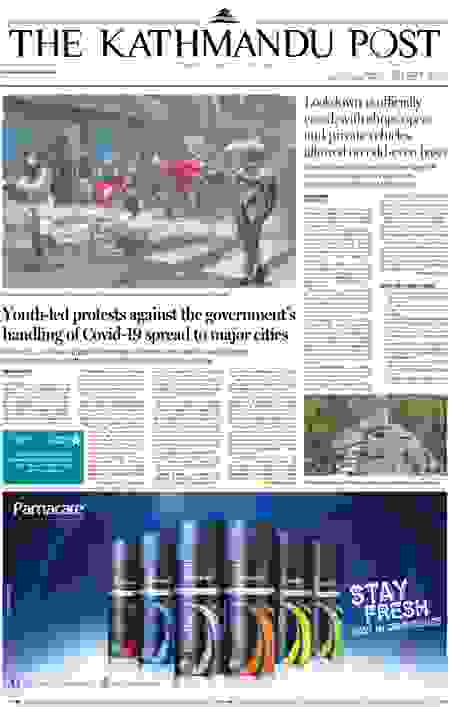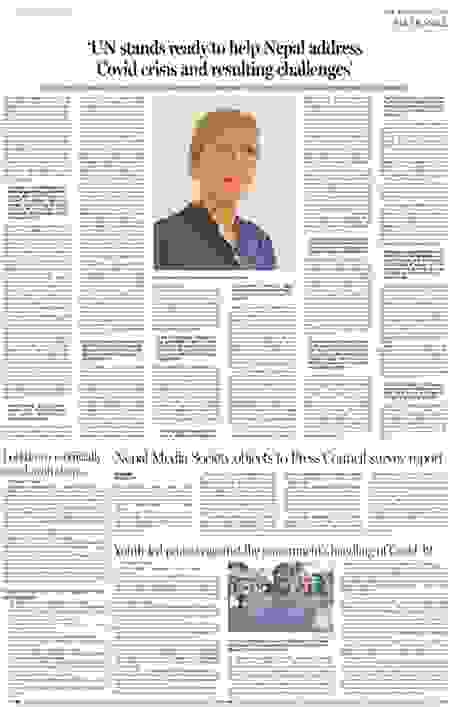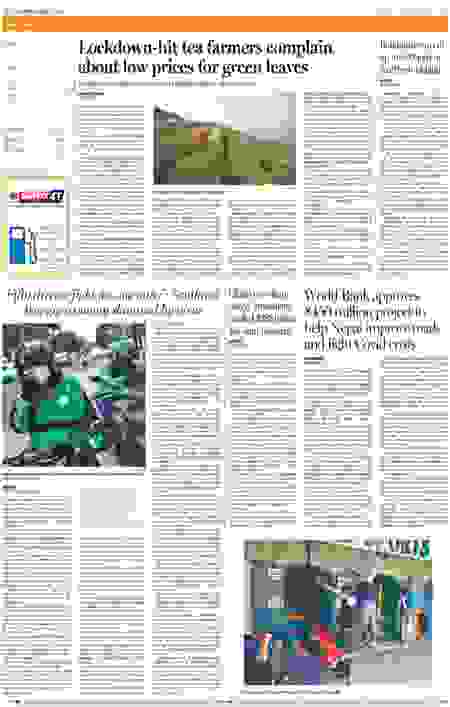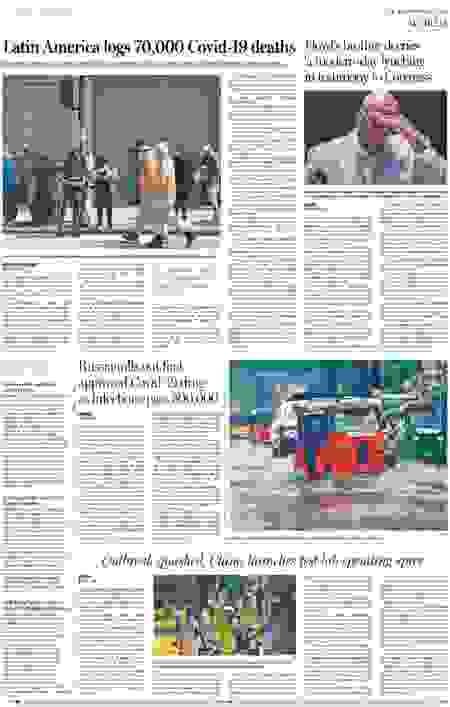NATIONAL
‘UN stands ready to help Nepal address Covid crisis and resulting challenges’
This crisis gives all countries an opportunity to steer their economy and development to a trajectory that is sustainable, gender-equal and carbon-neutral.
The Covid-19 pandemic has left an unprecedented socioeconomic impact globally and Nepal is no exception. Though the country witnessed a slow spread in the initial days, the contagion is increasing exponentially recently. On the other hand, the lockdown imposed to contain the spread of the coronavirus has shattered the economy, left many jobless, halted educational activities, and pushed poor communities deeper into poverty. In this backdrop, the Post had an email interview with Valerie Julliand, the United Nations resident coordinator in Nepal, to learn about how the UN has assessed the Nepal government’s response to the pandemic and the steps it has taken towards assisting Nepal in the fight.
The number of Covid-19 patients is increasing exponentially, around four months after the first case was reported in January. Have you assessed what could be the future scenario? Do you believe in the speculations that Nepal has yet to see its worst days?
We are facing an unprecedented global crisis. Though global in nature, the effects of Covid-19 vary from country to country and subsequently so do the approaches to preparedness and response. Each country has its own unique circumstances and capacities and thus, an approach suitable to one country may not be applicable to another. In Nepal, the government has taken proactive and early measures to stem the spread of Covid-19.
Across the world, health systems have been placed under enormous pressure and this is no different for Nepal. The government has taken measured steps to strengthen its health care system to cope with the pandemic, including an extraordinary effort to increase laboratory capacities across the country.
The impact of the pandemic is felt by everyone, but not equally. Those already vulnerable and marginalised are hit hardest. The impacts of the global crisis and the measures to curb the outbreak are already having very real effects on the lives of people in Nepal. Livelihoods have been lost; remittances cut. There is a risk that progress made by the government and people of Nepal towards gender equality, social inclusion, poverty reduction and conserving the environment may be lost. For the UN, it is our responsibility to support the government in protecting these achievements, reaching the most vulnerable and ensuring that commitments to Agenda 2030 and the Sustainable Development Goals are realised.
How satisfying is the present response from the Nepal government and its preparedness to respond to the pandemic?
This is a crisis that cannot be responded to by a single entity or government alone. Because it impacts everyone, everywhere, the pandemic also requires a global response, one which is composed of both global actions and individual country responses. At the national level, what is needed is decisive action from the federal, provincial and local governments, civil society, the private sector and the international community alike. This is a time for national and global solidarity.
Despite Nepal being a least developed country, having only recently recovered from a devastating earthquake, and being regularly impacted by floods, the country has been able to strengthen the health system and mitigate some of the short-term socio-economic impacts of the pandemic. Nepal now has 21 fully equipped laboratories that can carry out PCR testing, a designated Covid-19 hospital in each province, nearly 150,000 quarantine beds and relief packages have been distributed to 1.3 million households out of the 1.7 million estimated to be in need. These are significant achievements. However, a great deal more remains to be done and the UN stands ready to support in these efforts.
The decision of the government to place the country in lockdown and to close the borders responds to the logic of slowing the spread of the virus and “flattening the curve”. This is an effort to avoid over-burdening the health care system. This can potentially save more lives, even if a similar number of people get infected in the long run.
Of course, the very measures put in place to stop the spread of the virus have significant social and economic impacts. People cannot go to work and as most workers are in the informal sector and many wage workers, without daily income, they are unable to sustain themselves or their families. Businesses are collapsing. Saving the lives of people, at the same time as working to protect the economy is a courageous decision, but requires an adequate and swift socio-economic response, alongside a scaled up emergency response, that is health-focused. The UN is here to help the government in this effort too.
How is the UN working together with the Nepal government in combating the pandemic? How is it assisting the government agencies to prepare for the difficult time?
The UN stands ready to help Nepal address the possible crisis and challenges posed by the Covid-19 pandemic. This means that the UN and all its staff remain in the country to work on the preparedness and response efforts. We are using all available instruments, emergency financing, delivery of assistance including relief items, policy advice, and technical assistance to respond to the needs of the government and people of Nepal. Across all the UN agencies in Nepal, we are working to ensure that the response and recovery efforts are effective and well-coordinated, and most importantly inclusive of those most vulnerable and marginalised.
Our immediate and medium-term responses have focussed on Health System Support, and effort led by WHO Nepal, while also supporting a wider humanitarian response. A central role that the UN plays is in coordinating the humanitarian response efforts across UN Agencies, (I)NGOs, and development partners together with relevant line ministries.
There is widespread criticism that the government failed to conduct timely tests and questions have been raised over the quality of the test-kits as well. What is the UN’s assessment on this?
Testing allows the identification and isolation of those people who test positive. It is important that there is sufficient laboratory capacity to test all the samples that are taken. Over the last months, the government has scaled up this capacity from one to 21 laboratories that are able to perform the PCR test. This may need to be further expanded if the number of people requiring testing were to increase significantly. Testing capacity needs to match testing needs, which change over time.
The uncertainty followed by the weeks of lockdown is leading to a socio-economic downfall. What could be the recovery plan for Nepal? What could be the UN support for revival?
People have lost their livelihoods and sources of income. The economy as well as communities and families dependent on remittances from millions of Nepalis abroad are severely impacted and face an uncertain future. As has been the case globally, we also see an increase in gender-based violence (GBV) and a disruption in access to essential services, particularly affecting women. We can see that the crisis has hit those most vulnerable the hardest and made a segment of the population newly vulnerable.
The government has taken measures to mitigate the immediate socio-economic impacts and we can see also from the budget for the next fiscal year that the government has made a real commitment to addressing the needs of those most severely impacted by the crisis. As the UN it is our responsibility to provide our support to the government in addressing these socio-economic issues in rights-based, inclusive and gender-responsive ways.
We are currently formulating the “UN Framework for the immediate socio-economic response to Covid-19”, together with the government and other partners. Globally, the UN has identified five pillars for the response: i) protecting health services and ensuring continued delivery of essential services; ii) strengthening and expanding social protection systems; iii) protecting jobs, supporting small and medium-sized enterprises, and informal sector workers through economic response and recovery programmes; iv) introducing a macro-economic response which works for the most vulnerable and strengthens multilateral responses and; v) promoting social cohesion and strengthening community resilience.
This crisis gives all countries an opportunity to steer their economy and development to a trajectory that is sustainable, gender-equal and carbon-neutral. What we should aim for is that we build back new and better. As the UN, we support the government in identifying ways to achieve this, offering our expertise and backing in ensuring that we jointly move towards achieving the Sustainable Development Goals. Though there may be additional challenges, this should only motivate us to work harder to achieve the SDGs.
The government last week unveiled its policies and programmes for the new fiscal year. Is it right tracked to address the impact of the pandemic?
It is fundamental that policies, programmes, and budget allocations serve the most vulnerable people such as women, farmers, returnee migrant workers, and daily wage labourers. I can see that the government has made great efforts to put people at the center of response and recovery. In its upcoming budget, the government has rightly emphasised social protection, expansion of health insurance schemes, creating employment opportunities, servicing finances at subsidised interest rates, and providing tax exemptions or subsidies to micro, small, and medium enterprises (MSMEs), farmers, as well as to tourism enterprises.
Nepali communities, hugely affected by the pandemic, are likely to be hit hard by the rain-induced disaster this year too. With monsoon just a few weeks away, what role can the UN play in supporting the provinces and local governments?
As we approach the monsoon season, we are working together with the newly formed NDRRMA (National Disaster Risk Reduction and Management Authority) and government ministries, to jointly plan to prepare for, and respond to, flooding and landslides that may occur, taking Covid-19 into account. For now, this includes pre-positioning emergency relief supplies, lining up partners ready to deliver and developing plans to be ready to respond alongside the government at all levels, if they request our support.
The pandemic has weakened the health system, just while it has made women and children more vulnerable. How is the UN in Nepal looking at the scenario?
I would not say that the pandemic has weakened the health system. On the contrary, it has led the government to develop its laboratory capacity, to expand its hospital services, to improve its procedures. In addition to the 21 laboratories across the country now operational, essential guidelines have been formulated, health care workers have been trained and vast communication campaigns taken place. As a result, Nepal now has a more responsive health care system to meet this and future crises.
There is, however, a need to intensify efforts and enhance collaboration across the actors to ensure a response that addresses the needs of those most vulnerable.
Violence against women and girls has increased globally and in Nepal; women find themselves isolated and locked in with their abusers. At the same time, lockdowns have meant that reaching out for help and accessing essential services have become even more difficult. The UN is working to ensure that women and all those impacted can still access services.
The pandemic has affected the entire world. Could underdeveloped countries like Nepal seek the support from developed nations as they themselves are hit hard? How can they generate the resources for economic revival?
Almost all countries in the world are impacted, including those who support the development efforts here in Nepal. But what this crisis calls for is solidarity and that solidarity can be seen also in Nepal and the way in which the development community has responded. The UN Development System has made significant efforts to galvanise these global solidarities across member states, institutions and citizens. Donor countries have been generous, but more support is needed.
Many say that they cannot wait for things to go ‘back to normal’, but the normal that we had was not healthy, in so many ways it was destructive, to the planet and the people. And this is the opportunity of Nepal and all of us to change the future to be more sustainable and inclusive.
Do you agree attaining SDG targets has become more challenging now? What could be the post Covid-19 strategy for achieving the SDGs?
The UN is working to support all governments to prevent the crisis from derailing sustainable development efforts while laying out a vision for the affected to build a better future. The areas impacted by the Covid-19 are already reflected in the SDGs.
























